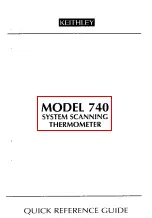
18
This device complies with the EU Directive 93/42/EEC con-
cerning medical products, the Medizinproduktegesetz (Ger-
man Medical Devices Act), the ASTM (American Society for
Testing and Materials) E 1965 - 98 and the European Standard
EN 12470-5: Clinical thermometers – Part 5: Requirements for
infrared ear thermometers (with maximum device) and the Eu-
ropean Standard EN 60601-1-2 (in accordance with CISPR 11,
IEC 61000-4-2, IEC 61000-4-3, IEC 61000-4-8), and is sub-
ject to particular precautions with regard to electromagnetic
compatibility.
Please note that portable and mobile HF communication systems
may interfere with this device.
3. Notes
Safety notes
WARNING
• To measure temperature, insert the sensor tip of the ear
thermometer carefully into the ear.
• Use of the ear thermometer on different persons can be inap-
propriate in the event of certain acute infectious diseases be-
cause of the possible spread of germs despite cleaning and
disinfection. If you have any doubts, please consult your doctor.
• The body temperature measured in the ear may differ from
other measurements taken in the mouth, rectum or armpits.
Any comparison of these values is therefore futile. Meas-
ure temperature regularly to calculate the normal ear tem-
perature and then use these measurements as a basis for
comparison when taking measurements in the event of a
suspected high temperature.
• This ear thermometer is intended for measuring the temper-
ature in the ear. Do not use this ear thermometer for meas-
urements in other parts of the body.
• Replace the protective cap after each use to ensure an accu-
rate measurement and prevent cross-contamination.
• The ear thermometer may only be used with protective
caps from Sanitas; other protective caps may result in faulty
measurements. If you have run out of protective caps, con-
tact the manufacturer or retailer for replacements.
• Consult a doctor if you believe your medical condition to
be poor.
Notes on handling batteries
WARNING
• If your skin or eyes come into contact with battery fluid, rinse
the affected areas with water and seek medical assistance.
•
Choking hazard!
Small children may swallow and choke
on batteries. Store the batteries out of the reach of small
children.
• Observe the plus (+) and minus (-) polarity signs.
• If a battery has leaked, put on protective gloves and clean
the battery compartment with a dry cloth.
• Protect batteries from excessive heat.
•
Risk of explosion!
Never throw batteries into a fire.
• Do not charge or short-circuit batteries.
• If the device is not to be used for a relatively long period, take
the batteries out of the battery compartment.
Содержание SFT 53
Страница 58: ...58 ASTM E 1965 98 EN 12470 5 5 EN 60601 1 2 CISPR 11 IEC 61000 4 2 IEC 61000 4 3 IEC 61000 4 8 3...
Страница 59: ...59 Sanitas...
Страница 60: ...60 4 1 2 3 4 5 1 2 3 AM PM 4 5 6 7 C F 8 9 10 11 12 5 1 2 3 4 5 E 1 5 7 6 8 9 10 11 12 2 3 4...
Страница 61: ...61 6 6 1 1 24 H 2 12 24 3 4 5 6 7...
Страница 62: ...62 6 2 C F C F 1 C 2 C F 7 30 7 1 6 6...
Страница 63: ...63 20 1 2 3 4 5 38 C 100 4 F 37 5 37 9 C 38 C 100 4 F...
Страница 64: ...64 7 2 1 2 3 4 1 2 5 7 3 3...
Страница 65: ...65 7 4 10 1 2 3 M 3 4 3 8 1 2...
Страница 66: ...66 3 1 5 AAA 9 10 Pb Cd Hg WEEE Waste Electrical and Electronic Equipment...
Страница 69: ...69 13...
















































